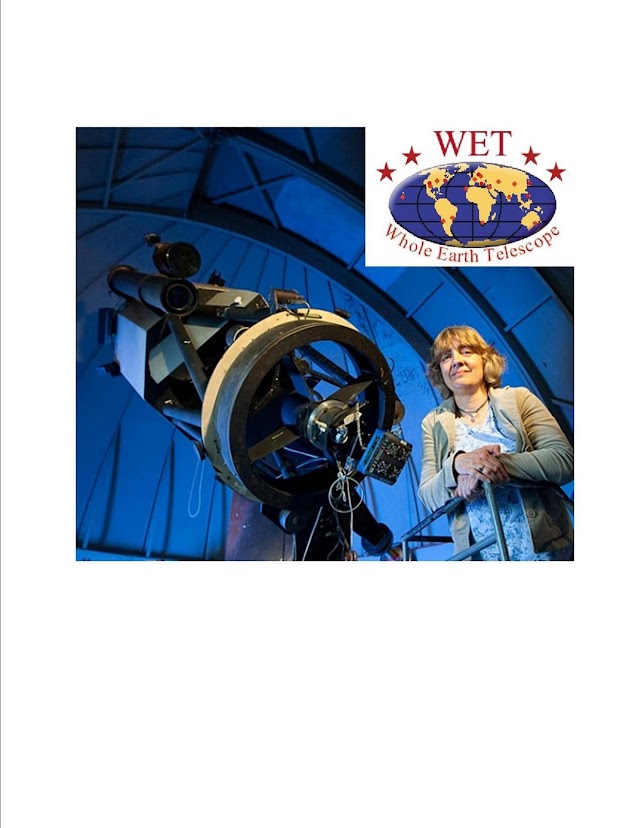Judi Provencal
- Judi Provencal
- B.A., Smith College, 1987 M.A., Astronomy, The University of Texas, 1990 Ph.D., Astronomy, The University of Texas, 1994 2005-present: Director, Delaware Asteroseismic Research Center 2005-present: Director, Whole Earth Telescope 2000-present: Resident Astronomer, Mt. Cuba Observatory and the University of Delaware
Saturday, May 28, 2011
Friday, May 27, 2011
Thursday, May 26, 2011
Monday, May 23, 2011
Damp04 Update
Hello everyone,
Damp04 is moving right along! We have been dealing with clouds, fog,
thunderstorms, telescope issues, ccd problems, and even some injuries!
But the data are still coming, and our targets are looking very
interesting.
We are now getting ready to enter the second busy part of Damp04. We
have some very interesting data so far. GD358 continues to be very
challenging. If you go to the website and click on "Interesting
Plots" you will see our most recent GD358 light curves and FTs. There
is a plot that compares the GD358 FT for the first part of the run
(until ~May 12) to the newer data (May 16-19). We had two days with
clouds and no new GD358 data. The peak at 1735.7 microhz is mostly
unchanged (1735.783 on May 12 vs 1735.987 on May 21) but we can see
several differences. The 954 microHz peak has increased from 2 mma to
15 mma. The 1247 microhz peak has behaved similarly (2mm on May 12 to
15 on May 21).
EC14012-1446 is also very interesting. This star was a 2008 XCOV27
target. The main frequency is 1633 microhz, one of the two largest
frequencies observed in 2008. However, its amplitude is now a
whooping 54 mma, over twice as large as observed in 2008.
Aleksandr has sent some wonderful pictures from Terskol, which I've
attached. Peak Terskol is a very beautiful place. We also have a
story from Willie Strickland at PJMO in Texas. I don't if everyone
remembers, but last year Willie had some surprise visitors to PJMO
(see Unwanted Guests). The guests were fortunately more interested in
the baby birds. This year Willie removed that tempation by placing a
styrofoam cup to keep the birds away:)
We have started a blog for this run. If you go to the run page and
click on "WET BLOG" it will take you there. It is still under
construction, but please check it out:)
Cheers,
Judi
Damp04 is moving right along! We have been dealing with clouds, fog,
thunderstorms, telescope issues, ccd problems, and even some injuries!
But the data are still coming, and our targets are looking very
interesting.
We are now getting ready to enter the second busy part of Damp04. We
have some very interesting data so far. GD358 continues to be very
challenging. If you go to the website and click on "Interesting
Plots" you will see our most recent GD358 light curves and FTs. There
is a plot that compares the GD358 FT for the first part of the run
(until ~May 12) to the newer data (May 16-19). We had two days with
clouds and no new GD358 data. The peak at 1735.7 microhz is mostly
unchanged (1735.783 on May 12 vs 1735.987 on May 21) but we can see
several differences. The 954 microHz peak has increased from 2 mma to
15 mma. The 1247 microhz peak has behaved similarly (2mm on May 12 to
15 on May 21).
EC14012-1446 is also very interesting. This star was a 2008 XCOV27
target. The main frequency is 1633 microhz, one of the two largest
frequencies observed in 2008. However, its amplitude is now a
whooping 54 mma, over twice as large as observed in 2008.
Aleksandr has sent some wonderful pictures from Terskol, which I've
attached. Peak Terskol is a very beautiful place. We also have a
story from Willie Strickland at PJMO in Texas. I don't if everyone
remembers, but last year Willie had some surprise visitors to PJMO
(see Unwanted Guests). The guests were fortunately more interested in
the baby birds. This year Willie removed that tempation by placing a
styrofoam cup to keep the birds away:)
We have started a blog for this run. If you go to the run page and
click on "WET BLOG" it will take you there. It is still under
construction, but please check it out:)
Cheers,
Judi
Friday, May 13, 2011
DAMP04
Hello everyone, We've completed the first stage of Damp04. Things are fairly quiet right now, with only two sites observing. Things will start to pick up again in a few days as more telescopes come on line in the middle of May. We have a very nice light curve of GD358, along with some preliminary data on WDJ1524, EC14012, and the KIC10139564. Take a look at the website (https://ms10.nss.udel.edu/wm/mail/fetch.html?urlid=0523e2a48046fdfab00361f80566c426b&url=http%3A%2F%2Fdarc.physics.udel.edu%2Fwet%2Fdamp04%2Fphptools%2Findex.php) under "Interesting Plots" to see the current light curve, FT, and a few other interesting plots. We have filled nearly every gap at a least once, especially at the beginning of the run, so the spectral window is decent, although the one day aliases have been growing back in. One of our goals with GD358 is to resolve the k=8 and 9 multiplets, the only two of GD358's modes that are always triplets. We have achieved this goal, and the resulting figure is given on the website. This figure monitors the width of the k=8 triplet, and the m=(0,1) and m=(0,-1) splittings since 1990. The asymmetric splitting can change, as it did during the 1996 "event" known as the whoopsie. This year, both splittings are nearly symmetric. The physical reasons are unclear, but the k=9 and 8 modes do seem to be behaving in interesting ways, as shown in the travelling FT figures also on the website. We will continue monitoring GD358 as the run continues, as well as obtaining more observations of EC14012 and WDJ1524. Cheers, Judi
Subscribe to:
Posts (Atom)







